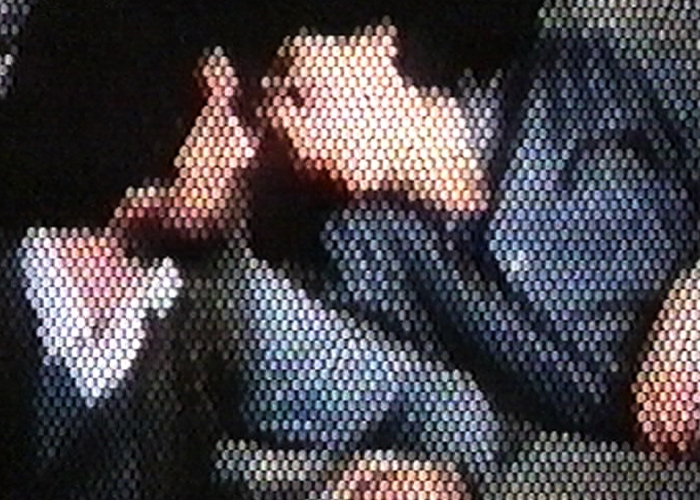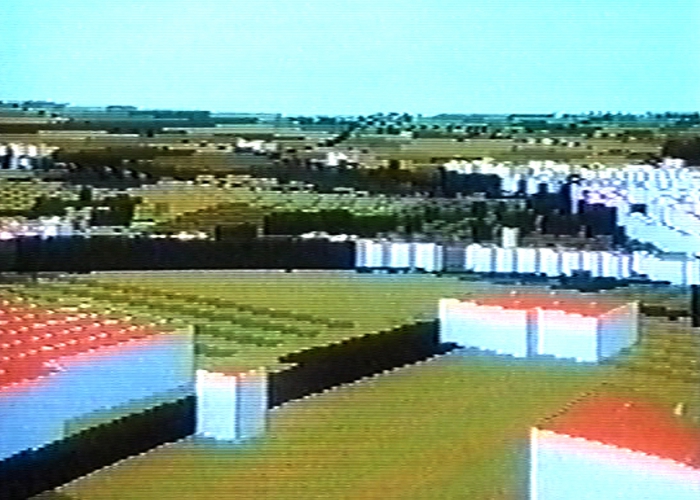Welttheater
Welttheater
“Due to the speed of computers, we are allowed into the center of events. We can treat the world and time as information. In this state, they are revealed as a different world and a different time. Yet everything remains in its place. Except that the world is now no longer unique. Yes, that’s what we have indeed lost, our stupid uniqueness. Our most favourite superstition.” So says Georg in Echtzeit. Georg is fascinated by the way digital data makes the world seemingly fully assessable and predictable. As he says to his lover, Ruth: “This kind of clairvoyance. This quiet sense of satisfaction at having access to extrasensory powers. Now all this has become true. I don’t understand why you can’t be totally happy about this.” Ruth is sceptical; she cannot share Georg’s enthusiasm about their alleged existence as a momentary state in a program, as a simulation of themselves. He keeps trying to counter her fears of losing human intimacy and ambiguity in a world of total predictability.
Ruth and Georg, played by Ruth Bierich and Georg Krämer, are the only two fictional characters in the film.
The main protagonist is a computer-generated landscape based on the terrain data of a low mountain range somewhere in Germany. It doesn't stem from imagination, nor is it reconstructed from photographs, but is a simulation of a natural landscape in real-time motion.1 In Georg's words: “The landscape exists twice now.” In several scenes of the film, actual computer scientists discuss the coloration and spatial depth of the digital imagery used in the simulation, technology they had developed for use in flight simulators over several years. Other scenes observe the production and application of computer hardware—from the assembly of satellite components to the clean-room processing of microchips—in order to emphasize the actual materiality of what the scientists, as well as Ruth and Georg, talk about.
Echtzeit constantly vacillates between documentary sequences, various kinds of found footage, and a fragmented fictional plot. The jumps between the disparate elements are marked by hard cuts, creating gaps and ellipses by which easy interpretation of how one relates to the other is defied. At some moments the different levels coincide, for example, when Georg meets the computer pioneer Konrad Zuse. Costard and Ebert have invited Zuse along with the scientists and engineers to join a guided tour of the grand staircase of the Würzburg Residenz, an enormous palace in the city of Würzburg. Designed by the court architect of the Bishop of Würzburg, Balthasar Neumann, and the Venetian painter Giovanni Battista Tiepolo around 1750, the staircase and its huge ceiling fresco entitled Großes Welttheater (Grand World Theatre) form a Baroque masterpiece. The architectural space is continued in the painted space, and the painted space extends into the architectural space. Reality and illusion merge. Moreover, the Großes Welttheater displays the four continents that were known to Europeans at that time, conveying an age-old desire for an image of the world in its entirety.
Later in the film, the group sits in a fireplace room together with the art historian and expert on the Würzburg Residenz. Inspired by the Baroque art of Neumann and Tiepolo, they converse about the significance of the synthetic landscape already familiar to the viewer. One of the scientists states that, in theory, the computer doesn't need to create the image of the landscape at all for its own operations. But because humans don't trust technology enough, they want to know what the machine is doing; that's why data has to be visualized in some form or other. For Costard, this highlights the fact that the actual events and processes determining the course of history have shifted into the realm of the invisible, most notably in the area of industrial production, where rationalization and automation caused high unemployment rates after the economic crises of the 1960s and 70s.2 Computer technology also played a major role in the development of modern weapons that combine new dimensions of explosive power and technical intelligence—another important concern expressed in Echtzeit in reference to the installation of the first Pershing II missiles in West Germany in 1983 and the nuclear arms race in the last decade of the Cold War.
Costard and Ebert sought a mode of narration that corresponded with the abysmal state of the world they perceived, what Costard called a state of dissolution.3 They therefore chose to dissolve the film image itself, less to disguise reality, but to make clear the nature of the image as image.44 For most of the film, Ruth and Georg appear only in an array of coarse colored dots. This fascinating grid effect is produced by a purely analog camera lens made of bundled glass fibers. In Echtzeit, the notion of the grid not only connects to the grid pattern of the computer graphic, but also to a surprising moment in which the fictional plot turns towards the urban reality and housing struggle of West Berlin. In one scene, startled by noise and shouting on the street, Georg goes up to the roof of the Max Taut Building on Oranienplatz in Kreuzberg, in which Costard then lived and where several indoor scenes of the film were shot. Documentary and fiction once more collapse into each other: from the edge of the roof Georg witnesses the eviction of real squatters. Policemen force a young man against a wall, place a hand-drawn number in front of his chest and photograph him. This procedure of police identification is a further symbol of the world having become information, and resonates with what has been largely debated at that time: the practice of so-called grid investigation introduced by West German police in the 1970s in reaction to the terrorist attacks of the Red Army Faction.
“Even chance has become part of the plan, part of reason,” Georg says at one point, foreseeing today’s discussions around the possible aleatory operations of algorithms and digital networks. Despite the pessimist tone of Echtzeit, Costard and Ebert didn't give up their belief that chance, errors, and mishaps can maintain something genuinely human even within computerized processes. They call their cinematographic method “a film without a script,” which actively allows for gaps and detours in the cinematic protocol. The ironic end of the film, a kind of postscript after Georg’s dramatic death in rural field where the real landscape and its computer simulation become one, features the TV footage of a presidential summit with Karl Carstens, François Mitterand, and Ronald Reagan in the Augustusburg Palace in Brühl. In front of another grand Baroque staircase built by Balthasar Neumann, the minor awkwardness of the participants undermines the most perfectly staged event, and releases the viewer of Echtzeit into laughter.
Better mind the crack in the mirror!



